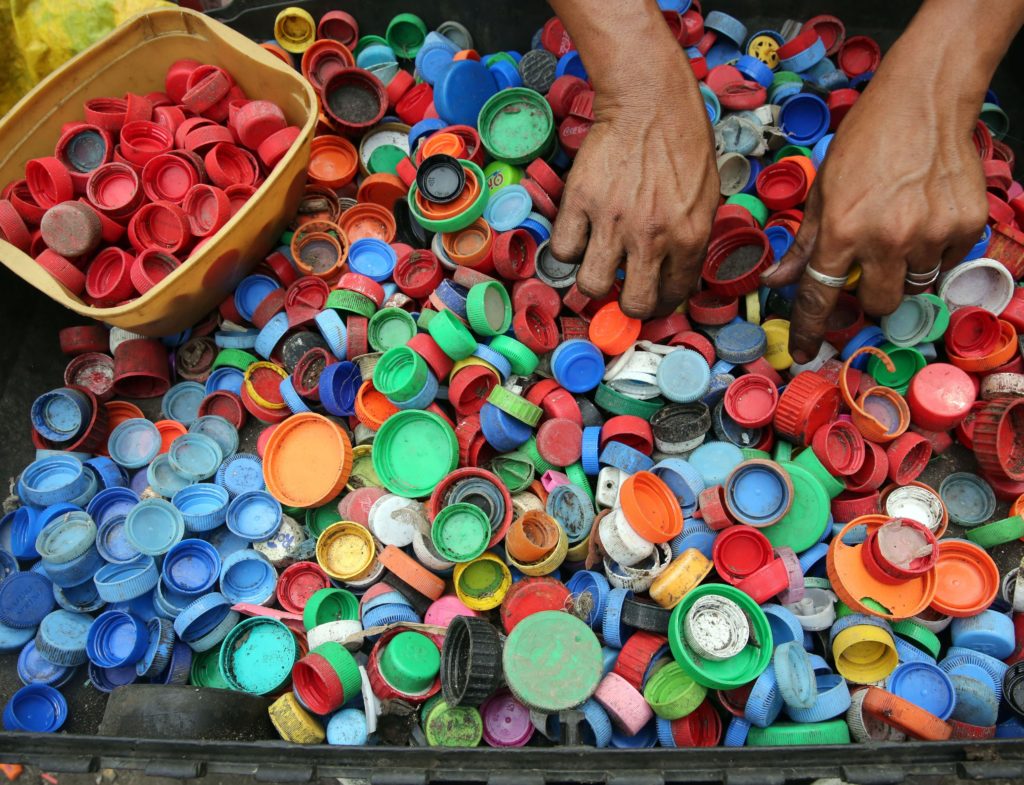

Features
Blockchain: Improving Human Agency in Environmental Decision-making
Dakota Walker
Share
This feature was originally published in Change Creator Magazine.
How do we as individuals promote environmental responsibility? Most would likely point to our indirect influence over a top-down regulatory system, but in fact, a large part of our role in environmental stewardship centers on purchasing behavior. Unsurprisingly, our actions as consumers have significant influence on many companies’ willingness to internalize a sense of responsibility for their environmental footprint. While this approach provides a more direct forum to express our values, bottom-up market pressures are only as effective as the information that guides decision-making and the markets that consumers have direct access to. Left with a guessing game of products’ negative externalities and limited —if not perverse— incentives to practice sustainability, one starts to wonder, what might a better system look like?
Imagine you walk into a store and pick up a pair of socks. Next to the material list is a breakdown of the environmental footprint and ethical sourcing considerations as they relate to an industry standard rating system. Having made your choice, you are prompted at checkout for the difference in carbon costs between the alternative products and given a digital token as a carbon credit, which you can choose to retire—thus reducing the available carbon in the global supply—or redeem for value. The transaction is then logged to your private digital identity so you can receive benefits from social impact investors via blockchain-based apps that reward your responsible purchasing habits. This hypothetical scenario describes a market that has improved product information, increased market capabilities, and aligned itself with our goals to progress sustainably. While it may seem far-fetched today, it’s quickly becoming a reality with the help of blockchain technology.
Blockchain is a digital ledger technology used to store, authenticate, and audit information on a massive scale. It is the infrastructure behind a new way of managing information with the potential to improve human agency in economic markets significantly. Much like Wikipedia and other crowdsourcing initiatives, it circumvents a centralized institution (in this example, Encyclopedia Britannica) and instead relies on contributions and verification by the thousands of computers using the technology. What is essentially a tamper proof and universal database is revolutionizing our capabilities around transparency, authentication and auditing. Deemed “the new operating system for society” and with over $4.8 billion dollars invested in related startups just this year, it’s sure to bring some disruption in near future.1,2
Informed Decision-making

Natural packaging materials and simplified labels help imply a drive for environmental or social justice, but ingredient lists and testing practices often tell a different story. Photo courtesy of Anna Sullivan/Unsplash
Consumers are increasingly making environmentally conscious purchasing decisions.3 In 2015, 72% of individuals aged 15-20 reported a willingness to pay a premium for products from environmentally or socially driven companies —up from 55% in 2014.4 The problem lies not in our collective intent, but in the information (or lack there-of) that helps us translate intent into effective purchasing decisions. Markets have become saturated with greenwashed product certifications and meaningless claims. As a result, consumers are unable to support environmentally progressive companies through purchasing decisions.
Furthermore, without effective means of tracing and reporting supply chain information, businesses can’t recognize their own environmental footprint and adapt accordingly. Fifty percent of total manufacturing costs come from raw materials and energy costs: often the two least transparent expenses.5 By improving supply-chain information, companies can recognize inefficiencies, optimize resource use, and remain competitive in light of environmental regulations. Total cost of ownership (TCO) or Lifecycle Assessments (LCA) have been vital tools for environmentalists and businesses alike, creating a clearer picture of all costs associated with the production, distribution, and disposal of a product. However, lack of information exchange along a supply chain (i.e. low interoperability) limits our true understanding of environmental impact.
Blockchain technology allows companies to contribute to a universal ledger of product reporting without needing to devote resources to managing the data. Provenance, a tech startup, has created a blockchain-based supply chain ledger that they are in the process of testing on the notoriously corrupt and ecologically damaging Indonesian tuna fishery. Initiated through a simple SMS text message, fishermen can establish a digital asset on the blockchain to represent each catch, then log relevant environmental and social attributes such as “fishing method, vessel type or compliance data.” 6 The block of information is updated at each point in the distribution chain, ultimately establishing a clear product lifecycle verified by third parties. Products can then participate in the “Provenance-validated chain of custody” marketplace, translating responsible fishing procurement into a significant price premium.6 For the first time it becomes not just feasible, but practical, to track products from cradle to grave —or better yet cradle to cradle.
Trustless Trust
Certain markets, however, are simply too complex to grant fine-grain transactions. The energy sector, for instance, constitutes 29% of total US GHG emissions, yet its rigid practice of centralized production, distribution, and management impede our ability to influence markets through consumer choice.7 Unfortunately, the market is tied up in our reliance on trust; without a tangible good, intermediaries are necessary to validate transactions. Because of this, our leverage to influence decision-making is limited; we can either buy energy from the utility company or not.

Lower Manhattan after Hurricane Sandy illustrates the unfortunate consequences of relying on a centralized energy grid. Image Courtesy of Several Seconds/Flickr
So, how might we create a market more accepting of consumer choice? While distributed energy grids are providing the physical infrastructure that can circumvent centralized distribution, and Community Choice Aggregation is providing the financial structure to allow individuals to invest in renewable energy regardless of their financial or space limitations, neither have addressed the outdated energy management system that necessitates centralized oversight.
Blockchain technologies are uniquely applicable to this sort of management process. Benjamin Dyrken, a cybersecurity attorney based in New York, explains that the technology “… allows us to take math, technology, and raw computing power, and turn it into a decentralized institution of trust.” What many are calling “Trustless Trust” is the missing link for a decentralized, peer-to-peer energy trading system, in which people who generate energy through renewable energy sources can sell energy directly to local buyers as opposed to selling it back to the grid.8
LO3Energy, the start-up behind an innovative microgrid pilot project in Brooklyn, NY, has created technology integrated with a blockchain platform to enable energy storing, buying, and selling at the neighborhood scale. In essence, this approach helped align energy procurement and distribution with market fundamentals, connecting multiple suppliers with even more buyers to establish a market price: true peer-to-peer transactions. Producers can be sure all energy is bought at fair rate, and buyers have access to different energy suppliers, bolstering consumer choice.
Value for Impact
Perhaps the most exciting potential application for blockchain technology is in impact investing, or investments made to benefit a specific environmental or social cause. Traditionally, investments are made directly to an organization that then invest the money in financial mechanisms in order to earn a return. The inherent problems with that approach are twofold: 1) investors have little assurance that the organization made the expected impact; 2) money can only go to large organizations, not individuals acting in a socially or environmentally responsible manner.
Proof of impact is a significant barrier to investment. Forty percent of respondents in a recent Global Impact Investing Network survey see performance data as a “significant” or “very significant” challenge to impact investing.9 What if investors could fund a specific outcome (like planting 100 trees) rather than funding the organization? Ixo Foundation has created a blockchain-based platform for doing just that. Organizations report each outcome, then after being verified by Ixo Foundation a digital token is granted as a certificate of the impact. The idea is that investors can apply funding to the creation of tokens, aligning an organization’s success with its ability to meet goals efficiently and honestly. “Fundamentally what they are buying is proof of the impact: a new digital asset that creates an opportunity for a new economy,” says Ixo cofounder, Shawn Conway.9 Investors see the effect of their funding and know their dollars are spent well.
So, if we can fund environmental impact at the organizational level, why can’t we fund those same outcomes by way of aggregated behaviors at the individual level? While in some cases, the impact of environmentally-responsible actions at the individual level can be equally, if not more effective than comparable efforts by organizations, the organizations have the advantage of trust —verification that the money was spent on social impact. However, with blockchain technology’s ability to provide distributed trust and verification, the market may soon be more inclusive of value for impact at the individual level. David Kish, a social intrapreneur, and Danielle Stanko, a sustainability advocate, illuminate the value in blockchain technologies: “By redefining business value in context of social issues, decentralized technologies like blockchain can create new social economies that fund social causes, stimulate social innovation and enable individuals to make a living through social impact.”

In recent years, there’s been a surge of new and exciting ways to reuse plastics. Image courtesy of Krizjohn Rosales
Plastic Bank is one example of how this market might develop. Collectors bring in plastic to be recycled and then receive tokens as value (above market price) for the plastic to be exchanged for dollars or bitcoin. The verified plastic (“social plastic”) is then processed and logged on a marketplace for its reuse. Individuals can even offset their own plastic use through investment in the organization. Traditional recycling markets fail to connect recyclers with the demand for recycled goods. The blockchain’s universal accessibility connects the two sides of this market, helping to create a truer market price for the environmental service.
Looking Forward: The Hard Truth
It would be irresponsible and misleading to assume blockchain’s net environmental impact will be positive. While it’s easy to be charmed by the potential for incredible progress, we must also recognize the significant energy costs of a system of value based on complicated computations. The combined electricity demand for computers in the Bitcoin system, one of the many cryptocurrencies based in blockchain technology, is predicted to hit 42TWh by the end of the year —higher than that of the entire country of New Zealand or Hungary.10
Ultimately, much of this relies on the system architecture. Ethereal, the blockchain technology behind most of the aforementioned start-ups, requires fewer computations for each block of information, thus reducing its carbon costs per unit of information. The long term success of blockchain as an environmental tool is linked to a system architecture that values sustainability and safeguards against greed and corruption. Fortunately, safeguarding is what blockchain does best: its decentralized nature lends itself to continual improvement through an egalitarian system of feedback. While the future of blockchain remains to be seen, the innovative approach to information management is sure to create ripple effects across how we operate as a society.
References
-
Jochem Verberne. (2018). How can blockchain serve society? World Economic Forum. Retrieved from https://www.weforum.org/agenda/2018/02/blockchain-ocean-fishing-sustainable-risk-environment/
-
Cryptocurrency ICO stats 2018. (2018). Coinschedule. Retrieved from https://www.coinschedule.com/stats.html
-
Normann, N., & Maier-Speredelozzi, V. (2016). Cost and Environmental Impacts in Manufacturing: A Case Study Approach. Procedia Manufacturing, 5, 58-74.
-
Nielsen. (2015). Green Generation: Millennials say sustainability is a shopping priority. Nielsen. Retrieved from http://www.nielsen.com/ie/en/insights/news/2015/green-generation-millennials-say-sustainability-is-a-shopping-priority.html
-
Greenovate! Europe. (2012). Guide to resource efficiency in manufacturing: Experiences from improving resource efficiency in manufacturing companies. Competitiveness and Innovation Framework Programme.
-
Provenance. (2016). From shore to plate; Tracking tuna on the blockchain. Retrieved from https://www.provenance.org/tracking-tuna-on-the-blockchain
-
Environmental Protection Agency. (2018). Sources Greenhouse Gas Emissions. Retrieved from https://www.epa.gov/ghgemissions/sources-greenhouse-gas-emissions
-
Zhang, C., Wu, J., Long, C., & Cheng, M. (2017). Review of Existing Peer-to-Peer Energy Trading Projects. Energy Procedia, 105, 2563-2568.
-
Ben Shiller. (2018). This New Blockchain Protocol Wants To Create Accountability For Social Impact. FastCompany. Retrieved from https://www.fastcompany.com/40513028/this-new-blockchain-protocol-wants-to-create-accountability-for-social-impact
-
Alex Hern. (2018). Bitcoin’s energy usage is huge – we can’t afford to ignore it. The guardian. Retrieved from https://www.theguardian.com/technology/2018/jan/17/bitcoin-electricity-usage-huge-climate-cryptocurrency
*Feature courtesy of Pixabay. Header image courtesy of William Bout/Unsplash
Dakota Walker
Dakota Walker is an Associate Project Manager & Research Analyst at Terrapin Bright Green. He recently graduated summa cum laude from the University of North Carolina Asheville with a degree in Environmental Management and Policy. Dakota believes the genius of nature has yet to be matched by human innovation. He’s interested in finding new approaches to solving contemporary policy and design challenges that reflect the resilience and resourcefulness of natural systems.
Topics
- Environmental Values
- Speaking
- LEED
- Terrapin Team
- Phoebe
- Community Development
- Greenbuild
- Technology
- Biophilic Design Interactive
- Catie Ryan
- Spanish
- Hebrew
- French
- Portuguese
- Publications
- Occupant Comfort
- Materials Science
- Conference
- Psychoacoustics
- Education
- Workshop
- Mass Timber
- Transit
- Carbon Strategy
- connection with natural materials
- interior design
- inspirational hero
- biophilia
- economics of biophilia
- Sustainability
- wood
- case studies
- Systems Integration
- Biophilic Design
- Commercial
- Net Zero
- Resorts & Hospitality
- Energy Utilization
- Water Management
- Corporations and Institutions
- Institutional
- Ecosystem Science
- Green Guidelines
- Profitability
- Climate Resiliency
- Health & Wellbeing
- Indoor Environmental Quality
- Building Performance
- Bioinspired Innovation
- Biodiversity
- Residential
- Master Planning
- Architects and Designers
- Developers and Building Owners
- Governments and NGOs
- Urban Design
- Product Development
- Original Research
- Manufacturing
- Industrial Ecology
- Resource Management
- Sustainability Plans
- Health Care
- Carbon Neutrality


